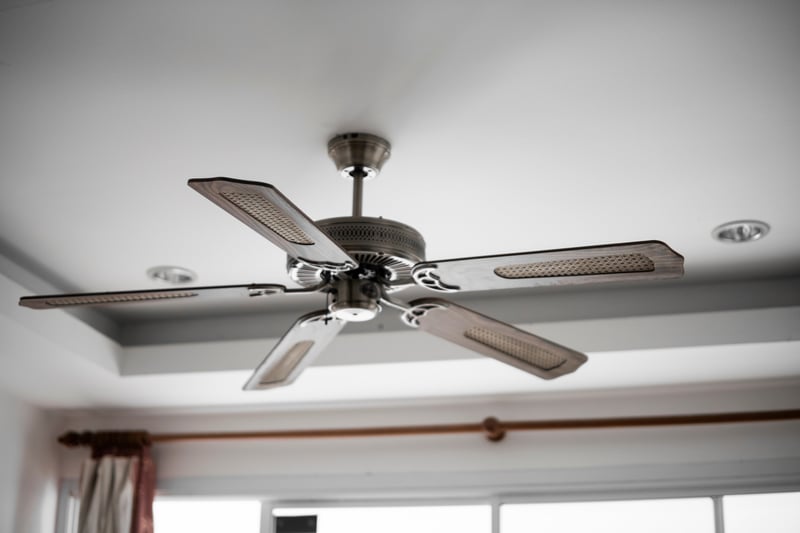Get Healthy!

- Dennis Thompson
- Posted August 17, 2023
How Kids Are Being Injured by Ceiling Fans
It's fun to playfully toss a toddler into the air, or tote a kid piggyback-style on your shoulders.
But those delightful giggles may come with a risk of head injury from a typically overlooked hazard -- the room's ceiling fan.
Each year U.S. emergency rooms treat about 2,300 children for head injuries caused by ceiling fans, according to Consumer Product Safety Commission data collected between 2013 through 2021.
These ER-treated injuries totaled more than 20,500 over the period, a new study in Pediatrics reports.
And there are probably a lot more that go uncounted, said lead researcher Dr. Holly Hughes Garza, an epidemiologist at Dell Children's Trauma and Injury Research Center in Austin, Texas.
"It's important to keep in mind we were only looking at kids who went to an emergency room for their injury, so we're not talking about every kid who bumped their head on a fan," Garza said. "There's probably a lot more kids that that happens to and they don't actually go seek medical care."
Lacerations are the most commonly treated injury from ceiling fans, with ER docs tending to cuts in 3 out of 5 (60%) cases, results show.
But concussions and skull fractures were also reported, the data indicate.
"They may be rare injuries, but at the same time they're injuries where if they occur, they can be severe,"said Dr. Sarah Combs, an emergency medicine doctor at Children's National in Washington, D.C.
"With little ones, you can imagine the speed and velocity of a fan -- especially if it's made of metal or something heavy -- going at their head,"said Combs, who was not involved in the study. "When they're going so quickly, it's essentially like a chopping blade."
The District of Columbia is a hot and humid locale, and Combs said the ceiling fans in her home certainly pose a hazard to her two young kids if adults aren't mindful.
"If you're lifting a child, especially if you're a taller person close to 6-foot, and you don't have the tallest ceilings, let's say your ceiling is only 7- or 8-foot, and then you have a drop on that ceiling fan by a couple of feet, it is pretty easy to get into that ceiling fan level,"she said.
Garza and her colleagues decided to research these sorts of pediatric injuries in the United States after reading international studies that found ceiling fans were a hazard in other countries.
One child died in Iraq from a head injury caused by a ceiling fan, and as many as 1 in 5 ceiling-fan-related cases treated in Australia involved skull fractures, the researchers said in background notes.
The U.S. results showed that head injuries from ceiling fans occurred most often at two age groups -- less than 1 year old and at 4 years old.
"For really young kids, even infant babies, we see that they can be hit by a ceiling fan when an adult lifts them up into the air and actually lifts them or tosses them up to impact the ceiling fan,"Garza said. "This could be sometimes done playfully and somebody just doesn't realize the fan is there, or just on accident they're lifting the kid up and the ceiling is low enough that they hit the fan."
Children under 3 had twice the risk of injury from being lifted or tossed up by an adult, compared with older children, the study found.
Many of the injuries among older children were related to placement of furniture in a room, Garza said.
"We saw a lot of these injuries happening when the kids were using a bunk bed or a loft bed, any type of furniture that was high enough off the ground that the kid was close to the ceiling fan, and then the fan hit their head,"Garza said.
Preventing these injuries means using a little imagination and on-the-fly math, Combs said.
"We get used to how our rooms look. You have a certain layout, you have the bed in a certain position and it might be partially under the fan,"she said. "You don't really think much of it, so that when you put two and two together that, hey, you know, the bed that's 3-foot-high is sitting right under a fan that has a drop of 2 feet on an 8-foot ceiling. If my 7-year-old stands on the edge of that bed, that equals a problem."
Parents who are renting a vacation home should be particularly mindful, Combs added.
"Going into an unfamiliar environment, just kind of take that in and just look around, take in where the hazards might be for a young child you're traveling with, and put that away in your mind so that you don't end up in an unfortunate incident in the middle of your holiday,"Combs said.
The study findings were published Aug. 17.
More information
HealthDay has more information on childproofing your home.
SOURCES: Holly Hughes Garza, DVM, MPH, epidemiologist, Dell Children's Trauma and Injury Research Center, Austin, Texas; Sarah Combs, MD, emergency medicine doctor, Children's National Hospital, Washington, D.C.; Pediatrics, Aug. 17, 2023

